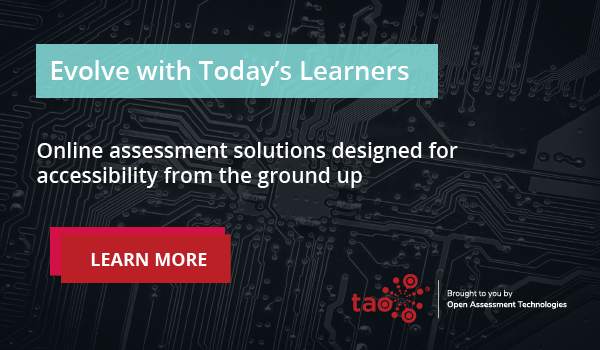Students today succeed through hands-on, personalized learning experiences. In addition, they’re increasingly turning into self-regulated learners, willing to learn through self-assessments of current knowledge or skills. Because of this, instruction methods such as adaptive testing are quickly gaining popularity as innovative tools to elevate educational outcomes.
What is adaptive testing, exactly? Adaptive testing is when educators use technology to gain data from learning interactions and deliver customized resources to address the needs of each learner. In other words, adaptive testing tools personalize the assessment to a student’s understanding of the subject.
Many vendors offer adaptive technologies for learning and assessment. However, before you invest in one tool or another, it’s important to ensure that your investment contributes to a larger framework that positively impacts student success at every step.
If you’re just starting to build an interoperable EdTech ecosystem at your school using IMS Global standards, read our post on Using IMS Global Standards to Connect Assessment to Learning.
In this post, we’ll discuss the IMS Global standard that makes adaptive testing methods possible: Computer Adaptive Testing, or CAT.
What is the CAT Standard?
Simply put, the CAT standard establishes interoperability between digital assessment platforms and adaptive testing tools. The standard eliminates the need for expensive proprietary integrations that would otherwise be necessary in order to add adaptive capabilities to assessments.
IMS Global provides a more technical definition of the CAT specification:
“The CAT standard treats adaptive engines as a black box, protecting the algorithm that powers the adaptivity and defines a simple API for secure communication between systems.”
The CAT standard connects learning algorithms with student data sets. The standard ensures that all data recorded from student interactions with learning tools or digital assessments gets securely passed from one system to another. This framework makes the learning process more efficient by selecting assessment items according to student knowledge in real-time.
The CAT specification also connects with the IMS Question and Test Interoperability (QTI) standard to utilize item metadata, scoring, and usage data into the adaptive algorithm. To learn more about QTI, check out our post, Empowering Online Education with Digital Testing Technology.
How the CAT Standard Supports Student Outcomes
The CAT framework allows the assessment to provide increasingly difficult or easier questions based on student performance. This approach reduces the time it takes to complete an assessment, since only relevant questions appear on the test, instead of requiring students to repeatedly respond to questions of all difficulty levels.
The additional benefits of an adaptive technology-enabled assessment include the following:
Fair performance measurement: Within an adaptive testing framework, all students’ performance can be measured on the same level, even if they interact with different items on the test. From a psychometric perspective, this increases fairness in grading and performance measurement. The large pool of items is also a compelling security benefit for online testing programs.
Increased precision: CAT-enabled assessments offer more precision than typical testing methods. Students receive a customized set of items according to the learning algorithm, instead of answering the same set of questions across the board.
Student experience: The CAT standard enables an appropriate challenge for each student taking the test. Thus, neither high performers nor low performers are discouraged or bored during an assessment. In addition, by interacting with proper levels of challenge and relief, students’ motivation tends to increase.
Finally, adaptive tests display student results and feed the data into learning algorithms in real-time. These advantages result in significant time and cost savings for schools while also providing optimal educational benefits to students.
—
The way we approach technology in education is rapidly changing — and schools all over the developed world will continue integrating EdTech into daily instruction. Make the smart decision for your school or district and establish an interoperable ecosystem that will future-proof your organization through new technology investments.
Whether it’s the CAT or QTI framework, or a dozen of others offered by IMS Global, taking these steps toward interoperability will set up your school — and students — for successful educational outcomes.
To learn more about interoperable EdTech and the future of digital assessments, check out our post on How Digital Assessment Tools Make it Easier to Prove Learning Outcomes.

